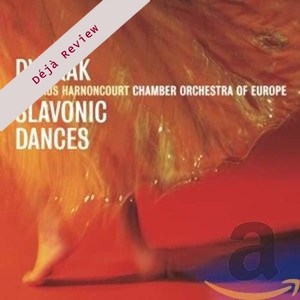
Déjà Review: this review was first published in June 2002 and the recording is still available.
Antonín Dvorák (1841-1904)
Slavonic Dances Nos 1-16, Opp 46 and 72 (1878 and 1886)
Chamber Orchestra of Europe / Nikolaus Harnoncourt
rec. 2000 (Op 72) and 2001 (Op 46), Stefaniensaal, Graz, Austria
Teldec 8573-81038-2 DDD [73]
I am in a bit of a quandary about this issue. It is perhaps the best played of any version in the catalogue, with the Chamber of Orchestra of Europe displaying a virtuosity which is absolutely staggering. This applies to both the fast and slow dances, and the phrasing is accurate, both in terms of pitch and speed.
So far, so good. Where I have reservations is in the level of charm. Played by a Czech band (such as the Czech Philharmonic under Karel Sejna, recorded by Supraphon in 1960) the playing sounds so right, with lilting strings and woodwind and with discreet percussion, the atmosphere is tangible. With Harnoncourt, the whole atmosphere is one of fast and furious, wherever possible.
It is not just a case of speed – it is more the phrasing which is so different. I am an avid fan of Harnoncourt’s interpretations of the late Symphonies of Dvořák with the Royal Concertgebouw, also on Teldec. Here, the corporate feel of the orchestra was never overridden, with the innate qualities of the playing of the orchestra never submerged by the conductor. In the case of the Slavonic Dances, the orchestra seems to be intent on delivering exactly what the conductor wants, the intervening year between the two sets of dances being indistinguishable from these recordings.
If you therefore like fast and furious performances of these pieces – even George Szell did not perform these dances with such gusto – I cannot think how you could possibly be disappointed with this release. There is not much point in comparing playing times because of the vagaries of repeats, etc. Also there is often a major difference in tempo between the middle section and the outer sections of the dances. The differences can make quite a difference to the total playing time of each dance.
It is the most exciting modern recording of these popular works that I have heard over the past few years. It is also interesting to compare it with the recent Philips recording of Dvořák’s masterpieces from Ivan Fischer and the Budapest Festival Orchestra. They perform the works with a more Eastern European flavour than the present issue, and whilst in no way superseding this, it gives the listener another approach to this life-enhancing music. I wouldn’t like to choose between the two issues, although personally, I would go back to Karel Sejna and the Czech Philharmonic every time.
Another feature of the current issue is that of the size of the orchestra. Textures are somewhat lighter with the smaller number of players involved, and the articulation is much clearer. Add to this the virtuosity of the players. Make no mistake, the current Chamber Orchestra is superb in this respect. With the smaller numbers, there is also a distinct difference in the balance between brass and woodwind against the strings. This is compensated for by the engineers somewhat, but the different relationship between these sections of the orchestra makes a difference which can be clearly heard.
Performance and recording is again absolutely superb, and I can recommend this release with all due enthusiasm. However if you really love the Slavonic Dances, I would urge you to seek out the earlier Supraphon issue to hear the genuine article. For those of you who just want the latest and best sounding recording, played with the utmost panache, go for this issue. Don’t however give the Philips issue a miss. Try to hear both and then make up your mind. Whatever the result, you will enjoy yourselves, because the ultimate winner is Dvořák, and each version has something special to say about these wonderful dances.
John Phillips
Buying this recording via a link below generates revenue for MWI and helps us keep free access to the site



















